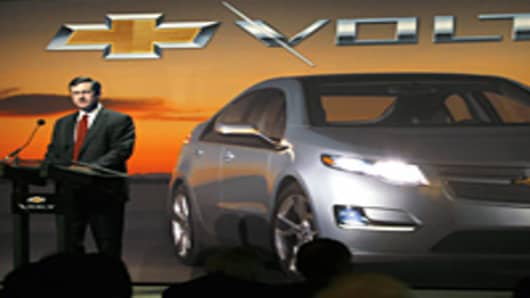During the company’s slide into bankruptcy, it had to suspend some of its investments. But Mr. Whitacre seems eager to play aggressive offense, and has the means to do it.
The cash hoard is as large as G.M. has ever had, including the days when the company was earning big profits on S.U.V. sales early this decade.
And it is bigger than the one at crosstown rival Ford Motor , which did not need help from the federal government. It had $23.8 billion in cash reserves at the end of the third quarter.
“Our mission is to design, build and sell the world’s best vehicles,” Mr. Whitacre said to 800 employees last Friday at G.M.’s technical center in Warren, Mich. “Will you all repeat that for me?”
G.M. has managed to hold on to its 20 percent United States market share since coming out of Chapter 11, despite moving to shut down its Pontiac and Saturn brands, and sell Hummer and Saab.
Yet G.M.’s sales incentives still rank among the highest in the industry, and many of its products were not recommended to consumers in a recent survey by Consumer Reports magazine.
The bankruptcy process, which forced the government to step in and lend it a total of $50 billion to survive, removed most of G.M.’s crushing debt load and long-term obligations to its retirees.
Now, Mr. Whitacre and his revamped management team must prove that they can spend taxpayers’ dollars productively on new cars, trucks and crossover vehicles.
“They have to establish themselves as the benchmark for the competition in each segment they’re in, as opposed to following everyone else,” said Joseph Phillippi, a principal in the consulting firm AutoTrends.
With hit products, G.M. could become profitable sooner. Once the company is stabilized, the government will have an opportunity to sell its G.M. shares in a public stock offering.
Some of G.M.’s cash is already spoken for. The company pledged to pay back $8.1 billion in loans from the United States and Canada by next year, and another chunk will go toward downsizing its European operations.
But G.M.’s new board has shown a willingness to spend more money on products to bring them to market faster.
At a meeting last month, directors offered to put another $100 million into the Chevrolet Volt if the company could get the battery-powered sedan into production sooner than its current start date in November, according to people with knowledge of the board’s move.
Dedicating more money for the Volt would not necessarily move up its timetable, said Jon Lauckner, G.M’s vice president for global product planning. But it could allow G.M. to build more vehicles for consumers to test-drive before full manufacturing begins.
“We have already reduced the Volt’s development time by about seven months,” Mr. Lauckner said in a recent interview. “Our date with destiny is November of 2010, but it could be useful for us to have the money to get some vehicles to consumers earlier than that.”
The automaker has also increased its budget for its next generation of full-size pickups and sport utility vehicles, said people involved in the program.
Mr. Whitacre and other new board members are eager to accelerate a number of product programs. One person close to the deliberations said directors had felt that the timetable of vehicles in development was too slow, with many models slated for 2013 and 2014 rather than sooner.
G.M. is also pouring money and resources into products it believes can change the company’s reputation.
One such model is a small, rear-wheel drive luxury car for the Cadillac division, referred to internally as the “BMW fighter” because it will compete head-on with the German carmaker’s 3-series sedan.
Mark Reuss, who was picked by Mr. Whitacre as the new head of G.M.’s North American operations, said the car would prove that a Cadillac can be every bit as exciting as the best that BMW has to offer.
“This car has to speak for itself,” Mr. Reuss said in a recent interview. “Before, it was all about playing defense instead of offense.”
Mr. Reuss, a career engineer who races and rebuilds classic cars, was a surprise pick last week for the top job in North America. But people familiar with Mr. Whitacre’s decision said that Mr. Reuss’s passion for cars was an important consideration in promoting him.
The new Cadillac will also benefit from what Mr. Whitacre hopes is a big change in how G.M. works with its suppliers.
In the past, the engineering team would produce specifications for parts and then turn them over to the purchasing staff to get the lowest price.
Now, the engineering and purchasing executives are meeting together with important suppliers to stress that G.M. will pay top dollar if it gets the most advanced technology before other automakers.
“With the BMW fighter, the steering in that vehicle is going to be absolutely critical,” said Mr. Reuss. “In the past we would have gone to the lowest cost source, but not anymore.”


